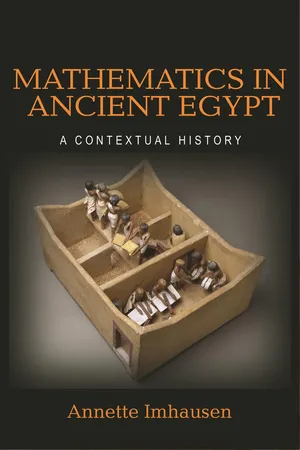![]()
MIDDLE KINGDOM
At the end of the Sixth Dynasty, the interplay of several causes (e.g., climatic changes that led to lower levels of inundation followed by famines but also an ever-growing administrative body that swallowed the available resources) caused the breakdown of the Old Kingdom. During the following First Intermediate Period (2160–2055 BCE) the central administration, in which the scribes had developed and executed their mathematics, broke down.1 Instead of the single authority at the head of the Egyptian culture, two centers of power fought for dominance: The north was ruled by the Heracleopolite Dynasty, based at the entrance to the Fayum. The south was under the government of another dynasty beginning with Antef I, based at Thebes.
On a regional level, local nomarchs, that is, high-level scribes, took over the responsibilities for the care of the population that had formerly been the responsibility of the king. While these nomarchs had used and developed their mathematics to serve the royal administration in providing for and organizing their communities, these abilities were now put to use in their own responsibilities of handling famines and ensuring the execution of basic procedures and securing social order. In their tombs, they proudly recorded their achievements. Thus, Ankhtifi, the nomarch at Hierakonpolis (and a supporter of the Heracleopolites), wrote in the autobiography in his tomb:
I am the vanguard of men and the rearguard of men. One who finds the solution where it is lacking. A leader of the land through active conduct. Strong in speech, collected in thought, on the day of joining the three nomes. For I am a champion without peer, who spoke out when the people were silent, on the day of fear when Upper Egypt was silent.2
Another official, Merer, from Edfu wrote in his stela:
Never did I hand a person over to a potentate, so that my name might be good with all men. I never lied against any person—an abomination to Anubis. And when fear had arisen in another town, this town was praised. I acquired cattle, acquired people, acquired fields, acquired copper. I nourished my brothers and sisters.
I buried the dead and nourished the living, wherever I went in this drought which had occurred. I closed off all their fields and mounds in town and countryside, not letting their water inundate for someone else, as does a worthy citizen so that his family may swim. When it happened that Upper Egyptian barley was given to the town, I transported it many times. I gave a heap of white Upper Egyptian barley and a heap of ḫmἰ-barley, and measured out for every man according to his wish.3
The individual success of a nomarch, as expressed in the autobiographies, was consequently no longer measured through his relation with a superior entity but through his ability to ensure social and economic stability within his own region and through his conduct toward the weak members of its society. In his daily life, then, the same mathematical knowledge that was formerly used to fulfill administrative duties for the king must have played an important role in order to assess, for example, the available grain rations or to organize the work that needed to be done. Through this ability, previously used in the service of the king, the nomarchs were now able to master the new responsibilities that had fallen to them.
However, presumably not all the First Intermediate Period was characterized through these harsh conditions. The height of the Nile inundations seems to have come back to a normal level, and the population must have felt some relief from the lack of monumental royal building projects. An indicator for a certain wealth among the population is the occurrence of a new type of burial goods, made for the Egyptian middle class, which made their first appearance in this period. Before, all but the wealthiest officials were simply buried with their former belongings; now, specifically made grave goods were available, indicating that there seems to have been enough demand for objects of this kind.
The First Intermediate Period ended with the resolution of the conflict between the two centers of power in form of the reunification of the country by the Eleventh Dynasty Theban king Nebhepetre Mentuhotep II (2055–2004 BCE). The following period of political stability and cultural flowering is known as the Middle Kingdom (Eleventh–Thirteenth Dynasties, ca. 2055–1650 BCE).4 It lasted until the Eastern Delta emerged during the later Thirteenth Dynasty.5 Within this period, several phases can be distinguished. During the Eleventh Dynasty, the centralized government was reinstated. Its structure was loosely based on the structure created in the Old Kingdom, where bureaucracy and crown were supported by taxation. The former system of local governors was kept; however, their number seems to have been reduced and they were under closer control of the royal court.6
After the Eleventh Dynasty, which had ruled from Thebes, there was a new phase beginning in the Twelfth Dynasty, when the capital was moved to the newly founded town of Itj-tawj (“Seizer of the Two Lands”) under its first king Sehetebibra Amenemhat I. Another break can be observed during the reign of King Senusret III through evidence of material culture and textual expression.7 The kings of the Eleventh Dynasty had sent expeditions to Punt (East Africa) to obtain incense and to Hatnub (alabaster) and Wadi Hammamat (graywacke). Similar expeditions then became more frequent during the Twelfth Dynasty, leading to increasing prosperity for the king as well as middle-class Egyptians. This enabled King Senusret I (1956–1911 BCE) to execute a major construction program, erecting monuments in every main cult site from lower Nubia in the south to Heliopolis and Tanis in the north.8 The Egyptian borders to Nubia were pushed further to the south and those west of the Walls-of-the-Ruler were consolidated with a series of massive fortifications. Several pharaohs reigning in peace and prosperity followed.
During this time, the Middle Kingdom rea...
